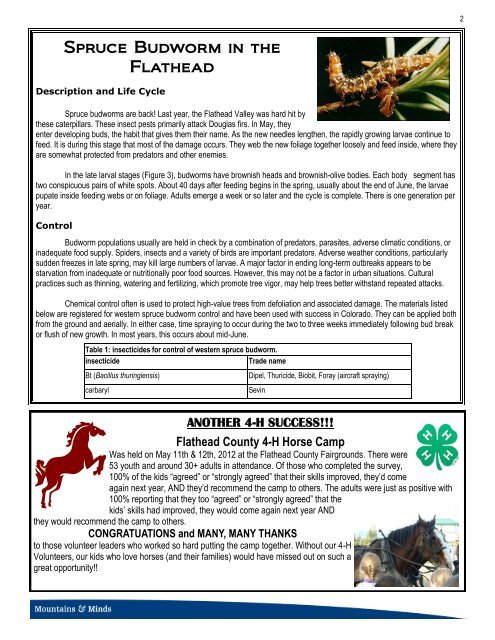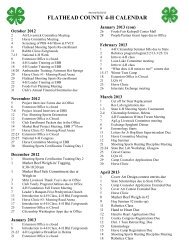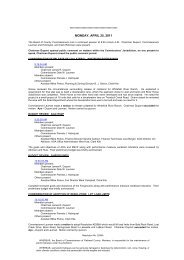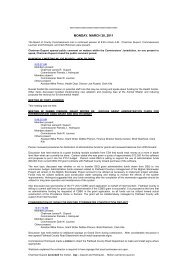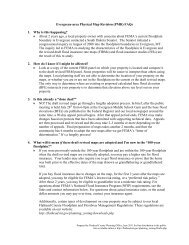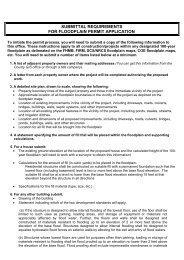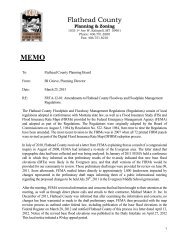Flathead County Newsletter - Flathead County Health Department
Flathead County Newsletter - Flathead County Health Department
Flathead County Newsletter - Flathead County Health Department
You also want an ePaper? Increase the reach of your titles
YUMPU automatically turns print PDFs into web optimized ePapers that Google loves.
Description and Life Cycle<br />
Spruce budworms are back! Last year, the <strong>Flathead</strong> Valley was hard hit by<br />
these caterpillars. These insect pests primarily attack Douglas firs. In May, they<br />
enter developing buds, the habit that gives them their name. As the new needles lengthen, the rapidly growing larvae continue to<br />
feed. It is during this stage that most of the damage occurs. They web the new foliage together loosely and feed inside, where they<br />
are somewhat protected from predators and other enemies.<br />
In the late larval stages (Figure 3), budworms have brownish heads and brownish-olive bodies. Each body segment has<br />
two conspicuous pairs of white spots. About 40 days after feeding begins in the spring, usually about the end of June, the larvae<br />
pupate inside feeding webs or on foliage. Adults emerge a week or so later and the cycle is complete. There is one generation per<br />
year.<br />
Control<br />
Spruce Budworm in the<br />
<strong>Flathead</strong><br />
Budworm populations usually are held in check by a combination of predators, parasites, adverse climatic conditions, or<br />
inadequate food supply. Spiders, insects and a variety of birds are important predators. Adverse weather conditions, particularly<br />
sudden freezes in late spring, may kill large numbers of larvae. A major factor in ending long-term outbreaks appears to be<br />
starvation from inadequate or nutritionally poor food sources. However, this may not be a factor in urban situations. Cultural<br />
practices such as thinning, watering and fertilizing, which promote tree vigor, may help trees better withstand repeated attacks.<br />
Chemical control often is used to protect high-value trees from defoliation and associated damage. The materials listed<br />
below are registered for western spruce budworm control and have been used with success in Colorado. They can be applied both<br />
from the ground and aerially. In either case, time spraying to occur during the two to three weeks immediately following bud break<br />
or flush of new growth. In most years, this occurs about mid-June.<br />
Table 1: insecticides for control of western spruce budworm.<br />
insecticide Trade name<br />
Bt (Bacillus thuringiensis) Dipel, Thuricide, Biobit, Foray (aircraft spraying)<br />
carbaryl Sevin<br />
ANOTHER 4-H SUCCESS!!!<br />
<strong>Flathead</strong> <strong>County</strong> 4-H Horse Camp<br />
Was held on May 11th & 12th, 2012 at the <strong>Flathead</strong> <strong>County</strong> Fairgrounds. There were<br />
53 youth and around 30+ adults in attendance. Of those who completed the survey,<br />
100% of the kids “agreed” or “strongly agreed” that their skills improved, they’d come<br />
again next year, AND they’d recommend the camp to others. The adults were just as positive with<br />
100% reporting that they too “agreed” or “strongly agreed” that the<br />
kids’ skills had improved, they would come again next year AND<br />
they would recommend the camp to others.<br />
CONGRATUATIONS and MANY, MANY THANKS<br />
to those volunteer leaders who worked so hard putting the camp together. Without our 4-H<br />
Volunteers, our kids who love horses (and their families) would have missed out on such a<br />
great opportunity!!<br />
2


